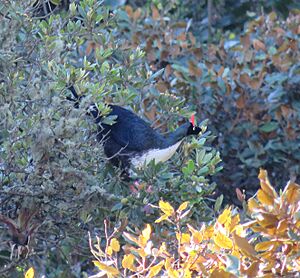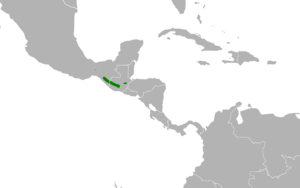Horned guan facts for kids
Quick facts for kids Horned guan |
|
|---|---|
 |
|
| Horned guan, Sendero Vega Del Volcan, San Marcos Department, Guatemala | |
| Conservation status | |
| Scientific classification | |
| Genus: |
Oreophasis
|
| Species: |
derbianus
|
 |
|
The horned guan (Oreophasis derbianus) is an endangered bird. It belongs to a very old group of birds called Cracidae. These birds are related to the Australasian megapodes, also known as mound builders. You can find the horned guan in Mexico, Guatemala, and possibly Honduras.
Contents
Understanding the Horned Guan's Family Tree
The horned guan looks a bit like other guans. However, it is not closely related to them. Its unique horn might remind you of helmeted curassows. This bird is the only living member of a very old bird group. It has been evolving on its own for at least 20 million years. Some scientists even think it could be as long as 40 million years! Because of its unique history, the horned guan is often placed in its own special group.
The very first horned guan specimen studied by scientists is kept in the National Museums Liverpool. You can find it at the World Museum. This bird was collected around 1843 in Guatemala. It was later given to the people of Liverpool. The horned guan is also a monotypic species. This means it is the only species in its genus.
Physical Features of the Horned Guan
The horned guan is a large bird. It measures about 75 to 85 centimeters (30 to 33 inches) long. Its most special feature is a tall, red, fleshy "horn" on its forehead. It has a small head and strong, long legs. Its tail is also long and wide.
Males and females look similar in their feathers. But males have a taller horn. They also have longer wings, tails, and legs than females. Adult birds have a shiny black head, neck, and upper body. These parts have a blue shimmer. Their tail is black with a wide white band near the bottom. Their throat, chest, and upper belly are whitish with black spots. The lower belly and sides are brown. They also have a small red flap of skin under their chin. Their eyes are white, their bill is yellow, and their legs and feet are red. Young horned guans look like adults. However, their colors are duller and their horn is smaller.
Where Horned Guans Live and Their Homes
You can find the horned guan in southern Mexico, especially in Chiapas. It might also live in Oaxaca. It is also found in southern Guatemala. There are some reports from Honduras, but these are not confirmed. This bird does not live everywhere in these areas. Instead, it lives in specific, local spots.
The horned guan prefers humid, subtropical mountain forests. These include cloudforests and pine-oak forests. Their homes often have lots of small plants. These include tree ferns, epiphytes (plants that grow on other plants), moss, and vines. They usually live at high elevations. This is typically between 2,300 and 3,100 meters (7,500 to 10,200 feet). But sometimes they can be found lower, around 1,200 meters (3,900 feet). They can also live as high as 3,350 meters (11,000 feet).
Horned Guan Behavior
Daily Movements
The horned guan stays in the same area all year long. It does not migrate.
What Horned Guans Eat
Horned guans mostly eat many different kinds of fruits. Green leaves are also a big part of their diet. They eat small amounts of flowers and possibly insects too. They search for food alone or in small groups. They look for food at all levels of the forest, even on the ground. Many seeds pass through their bodies without being digested. This means they might help spread seeds for new plants to grow.
Reproduction and Life Cycle
Most of what we know about horned guan breeding comes from a study in Mexico. This study was published in 1995. Their breeding season seems to be from January to March. Scientists believe that one male might mate with several females. A male might spend a few days with three to five females.
Their nest is shaped like an oval. It is made of dry leaves and roots. They usually build their nests high in a tree, often near running water. A female lays two eggs. She sits on the eggs for 34 to 36 days until they hatch. The young chicks leave the nest about three to six days after they hatch.
Horned Guan Calls
Male and female horned guans make very different sounds. Males have at least five different calls. Females have seven or eight calls. Female calls are described as "guttural" and louder than male calls. The main call of the male is a deep, slow, and soft "mooing" sound. It has seven notes. This call can be repeated for an hour! Females usually call back to the males. Their calls sound like "guurk, guurk, guurk" or "guauuu, guauuu, guauuu."
Horned Guan Conservation Status
The IUCN (International Union for Conservation of Nature) first listed the horned guan as "Threatened" in 1988. Then, in 1994, it was changed to "Vulnerable." Since 2000, it has been listed as "Endangered." This means it is at a high risk of becoming extinct.
The horned guan lives in a very small area. Scientists believe there are only about 600 to 1,700 adult birds left. This number is thought to be going down. Their habitat is shrinking because of logging and collecting firewood. Forests are also being turned into farms. Hunting also puts pressure on the birds.
When groups of horned guans become separated, they are more likely to disappear. Climate change is also expected to make things worse. It could cause their already small living areas to shift. The good news is that the horned guan lives in at least one protected area in Mexico and Guatemala. However, one of its largest populations lives on the Volcán Tacaná. This volcano is on the border between the two countries and is not protected.
Images for kids



